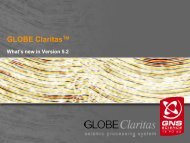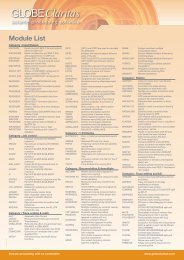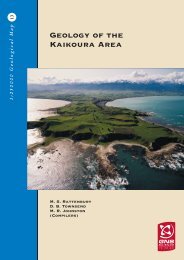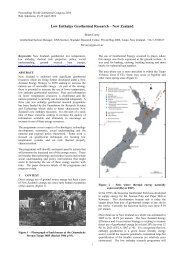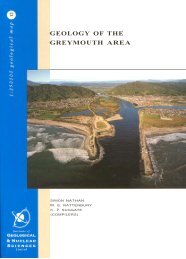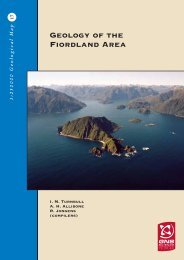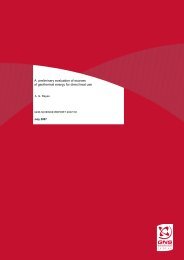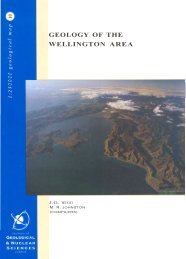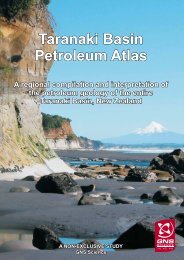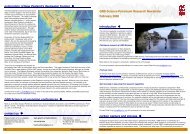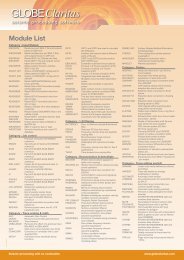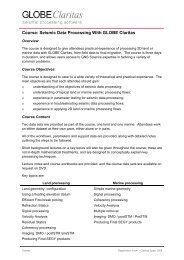GEOLOGY OF THE - GNS Science
GEOLOGY OF THE - GNS Science
GEOLOGY OF THE - GNS Science
Create successful ePaper yourself
Turn your PDF publications into a flip-book with our unique Google optimized e-Paper software.
e within the East Coast Allochthon (Mazengarbel al. 1991a; Field, Uruski el al. 1997)he suggested no group nameno type section was nominated, but the referencesections are both within the East Coast A llochthon• MazengarlJ el al. (l99 Ia) included Tikihore andTapuwaeroa formations in their RU3toria Groupaccording to their definition, "Ruatori a Groupenco mp asses al l primari ly sed imentaryall oc hthonous formations underl y in g th eallochthonous part of the Tinui Group..."the intent was thal Ru atoria Group was to apply10 the allochthonous units, but not to theautochthonous units.Ruatoria Group is therefore expanded to includeallochthonous Tikihore and Tapuwaeroa rocks, and alsothe apparently autochthonous equivalents_ It is lhereforeanalogous to Tinui Group which has components (e.g.Whangai Formation) in both the autochthon and the EastCoast Allochthon.There is near-continuousexposure of 1060 m ofTikihoreFormation (Kri) and Tapuwaeroa Form,ltion (Krp)in the lower Mata Ri ver area (Y 15/648473), in astructurally si mple settin g. Inoceramid fossils indicatethe sequence has an age range of Cenomanian toSa nton ian (Arowhanan-Piripauan).The Tikihore Formati on is mainly centi metre- to metrebedded,alternating, fine-grained sandstone andmudstone. Sandstones typically show normal grading,with common sole structures, trace fossi lsand incompleteBouma sequences; deposition is inferred to have beenfrom turbidity currents. Five sedimentary cycles arerecognised, each starting with a thick (up to 20 m) slumphorizon which is overlain by thick (up to 3 m) len ticu larsandstones, fo llowed by the more typical alternatingsandstone and mudstone (Laird el al. 1998a, 1998b).Bioturbated hori zons and intervals are common withinmudstone and there are zones of abundant inoceramidfossils, some up to I m across, and apparently litlletran sported from growth position. It has been argued thatinoceramids in growth position indicate TikihoreFormation accumu lated at relatively shallow depths, butthe use of life position alone as an indicator ofpaleobathymelry is now known 10 be unreliable(Crampton 1996). The extent of the formation, its greatthickness. monotonous facies and sedimentary structuressuggestT1kihore Formation accumulated as a submari nefan or fans. in deep marine (slope to bathyal)environments (Mazengarb 1993).At Mata River the Tikihore Formati on passes upwardgradational ly into the sandstone-dominated TapuwaeroaFormation ; th e contact is pl aced at a Coniacian (Teratan)intraformational breccia unit 22 m thi ck. Late C retaceousdecimetre- to metre-bedded, sandstone-dominated,alternating sandstone and mudstone beds present locallyat Mahia Peninsula (e.g. Webb 1979) are also inferred tobe au tochthonous Tikihore and Tapuwaeroa formations,for they lie well south of the inferred southern limit ofthe East Coast Allochthon. In southern Hawke's Bay andWairarapa si milar beds have been mapped as GlenburnFormation (Field, Uruski et al. 1997).Late C retaceous to Paleocene rocksFro m the western map boundary ncar Koranga as farnortheasl as Ihungia the Matawai Group is overlain bythe mudstone-dominated Tinui Group (Moore et al.1986) of latest Cretaceous to Paleocene (PiripauanTeurian) age. As the Matawai Group rocks were fo lded,uplifted and, in some areas, deeply eroded beforedeposition of the Tinui Group, the contact between thetwo is a low to mooerate angle unconfomlity of regionalextent.Over a distance of about 100 km. from Te Hoe Ri ver inthe southwest (50 km beyond the Raukumara mapboundary) to Moutohora inl-he northeast, the basal T inuiGroup beds are massive to we ll bedded, relativelyquartzose fine-grained sandstones, with minor glauconiticsiltstone and glauconitised siltstone breccia (TahoraFormation, Kit). Tahora Formati on is inferred to havebeen deposited in beach to mid shelf environmentsfollowing renewed marine transgression in Piripauan time(Crampton & Moore 1990; Isaac et al. 1991 ). Within thearea covered by the Raukumara map the TahoraFormation is typically less than 50 m thick and presentover areas too small to differentiate at 1:250 ()()() scale.Further east, up to 100m of upward-fining, we ll beddedsandstone and mudstone (Owhena Formation, Kio) ispresent in th e sa me stratigraphic position over ageographi ca ll y rest ri cted area along Waitahaia Ri ve r(Phill ips 1985). The immediately underlying KarekareForm at io n is intense ly burrowed, w ith abundantcalcareousconcreti ons. Owhen3 Formation is interpretedas a deeper water equivalent of Tahora Formation,deposited by sediment grav ity flow mechanisms in outershelf and slope environments.Tinui Group basal sandstone facies are confonnably andin places gradati onally overlain by the WhangaiFormation ( Kiw), a thick, mudstone-dominated unitwidely recognised throughout eastern New Zealand(Northl and , Raukum ara Peninsula, Hawke's BayWairarapa and Marlborough) and in adjacent areasoffshore (Lillie 1953; Moore 1988b; Field, Uruski el al.1997). The Whangai Formation typically consists of300500 m of nonca lcareous and ca lcareous shale andmudston e. In western areas the formation is typicall y20



